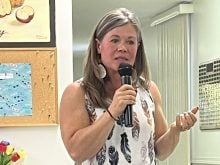NORTH BATTLEFORD, Sask. – A prairie-wide water board could help strengthen water management, development and conservation and protect watersheds for human health.
A host of speakers floated the idea at a conference here Nov. 4.
Graham Parsons, vice-president of Clifton Associates Ltd., said the proposed federal council would address the big gaps in water management structures, invest in water storage, treatment and planning and help avoid water contamination problems experienced in North Battleford in recent years.
“When it’s locally based, it deals with local issues,” he said, adding such a board could also provide a model for other areas of Canada. “The federal government needs to dialogue directly with citizens.”
Read Also

Alberta may eliminate marked fuel
Alberta may soon stop selling dyed gasoline and diesel.
The federal government is involved with water issues across 22 different agencies, so it has a vested interest and role to play in a council, he said.
The Saskatchewan Water Council, created by Saskatchewan Agrivision Corp. and chaired by Wayne Clifton, hopes to grow to encompass such a prairie-wide structure within two months.
Clifton said a council can provide a vehicle to continue progress on water issues and spread information to the public.
Citing steady decline in Saskatchewan farming communities, he said this board could continue with the Saskatchewan council’s role to create healthy communities and economies and sustainable ecosystems.
Clifton said drought-proofing the province against boom and bust cycles is important and he proposed more dams and storage reservoirs as part of the solution.
“Drought two years out of 10 means industry cannot prosper,” he said.
Clifton said uncertainties about the effects of global warming on glaciers and snowpacks make it more important to capture more precipitation.
He said more research is needed and suggested an update for a study done in 1972 that identified potential storage sites. They included the High Gate dam, currently being explored near North Battleford.
David Orchard, who runs an organic farm near Borden, Sask., dismissed the need for more large-scale dam projects, citing the 300 dams being decommissioned in the United States.
“We need to make better use of what is already there,” he said.
That doesn’t necessarily mean more irrigation, he said, noting further study is needed on the use of water in irrigation systems.
“Is it the panacea that we thought it was to save farms or has it created more problems?”
Orchard criticized the conference for tapping government funding to do “unabated boosterism” of one point of view. He cited the number of self-interested parties involved that include engineering firms that stand to benefit from the large-scale water development.
Parsons and Clifton agreed all points of view need to be heard by a water council, but they said change is coming.
“I can’t figure out a way to keep five million people on the Prairies without water management changes,” said Parsons.
Clifton said the people will ultimately decide what happens with water development.
“Everybody within the forum recognizes all these developments are at the pleasure of the public,” he said. “If they’re acceptable to the population, they will occur. If they’re not acceptable, they won’t occur.”
Proponents of a prairie water council would like to see it receive funding for research and education, have the capability to focus resources and plan and develop for the changing climate.
Parsons discounted using existing organizations like the Prairie Farm Rehabilitation Administration, now under Agriculture Canada, saying water is broader than just agriculture.
“It needs an authority that would have a bigger clout,” he said, suggesting a budget of about $500 million.
A council would look at whether existing storage is adequate, examine changes due to global warming, study long-term solutions, initiate studies on water quality and quantity and examine sustainability.
It would evaluate new storage sites, farm water plans, pipeline planning, municipal water supplies, monitoring and treatment equipment and wetland development.














